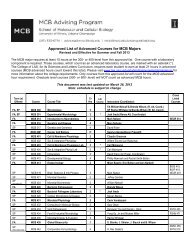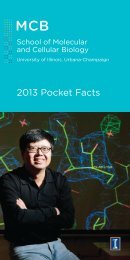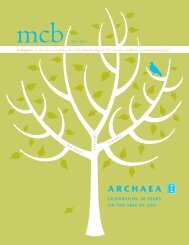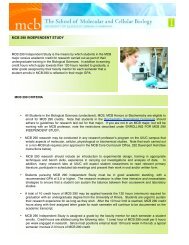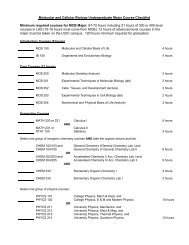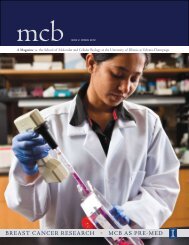collaboration in the life sciences - The School of Molecular and ...
collaboration in the life sciences - The School of Molecular and ...
collaboration in the life sciences - The School of Molecular and ...
You also want an ePaper? Increase the reach of your titles
YUMPU automatically turns print PDFs into web optimized ePapers that Google loves.
Histone H1, a prote<strong>in</strong> that helps pack DNA<br />
<strong>in</strong>to <strong>the</strong> cell nucleus, has an important role <strong>in</strong><br />
regulat<strong>in</strong>g gene activity. Associate Pr<strong>of</strong>essor <strong>of</strong><br />
Cell <strong>and</strong> Developmental Biology Craig Mizzen<br />
<strong>and</strong> colleagues also found that histone H1 takes<br />
part <strong>in</strong> <strong>the</strong> formation <strong>of</strong> ribosomes, <strong>the</strong> cellular<br />
workbenches on which all prote<strong>in</strong>s are made.<br />
A human cell’s genetic material is so vast that it must be condensed<br />
<strong>in</strong>to tightly wound structures resembl<strong>in</strong>g beads on<br />
a str<strong>in</strong>g. <strong>The</strong> DNA w<strong>in</strong>ds around four core histone prote<strong>in</strong>s<br />
to form one <strong>of</strong> <strong>the</strong> “beads,” while H1 or “l<strong>in</strong>ker” histones<br />
clamp <strong>the</strong> DNA <strong>in</strong>to place where it enters <strong>and</strong> exits <strong>the</strong> beads<br />
(see figure oppposite). One bead <strong>and</strong> its associated DNA<br />
make up a nucleosome. <strong>The</strong>re are over ten million nucleosomes<br />
<strong>in</strong> <strong>the</strong> nucleus <strong>of</strong> a cell.<br />
<strong>The</strong> new study found that when H1 histones are modified by<br />
<strong>the</strong> addition <strong>of</strong> a phosphate group, a process called phosphorylation,<br />
that modification is associated with changes <strong>in</strong><br />
gene activity.<br />
“Most studies <strong>of</strong> histone phosphorylation have focused on<br />
cell division, when phosphorylation is at its peak,” said Mizzen.<br />
Dur<strong>in</strong>g cell division “much less <strong>of</strong> <strong>the</strong> genome is transcribed<br />
than at o<strong>the</strong>r po<strong>in</strong>ts <strong>in</strong> <strong>the</strong> cell cycle.... Everyth<strong>in</strong>g<br />
is geared toward separat<strong>in</strong>g <strong>the</strong> replicated genome copies<br />
equally between <strong>the</strong> new daughter cells.”<br />
Suspect<strong>in</strong>g that H1 phosphorylation was important for<br />
processes besides cell division, Mizzen <strong>and</strong> his colleagues<br />
identified <strong>the</strong> exact sites <strong>in</strong> H1 that are phosphorylated dur<strong>in</strong>g<br />
various portions <strong>of</strong> <strong>the</strong> cell cycle.<br />
<strong>The</strong>n-doctoral student Yupeng Zheng developed antibodies<br />
that recognize phosphorylation at <strong>the</strong> H1 sites cells use<br />
when <strong>the</strong>y are not divid<strong>in</strong>g. This enabled Zheng to discover<br />
that such “<strong>in</strong>terphase” H1 phosphorylation is preferentially<br />
associated with genes when <strong>the</strong>y are actually be<strong>in</strong>g transcribed.<br />
craigMIZZEN<br />
“Histones are normally found all over <strong>the</strong> genome,” Mizzen<br />
said, “<strong>and</strong> elucidat<strong>in</strong>g what is different about <strong>the</strong> nucleosomes<br />
on active genes versus those on repressed genes versus<br />
<strong>the</strong> rest <strong>of</strong> <strong>the</strong> genome, most <strong>of</strong> which is not prote<strong>in</strong>-cod<strong>in</strong>g,<br />
is a central goal <strong>of</strong> current research <strong>in</strong> molecular biology.”<br />
Several core histone modifications are known to localize<br />
preferentially to active genes, Mizzen said. “But our work<br />
provides <strong>the</strong> first evidence that this is also true for H1 that is<br />
phosphorylated at specific sites.”<br />
Zheng also made a second surpris<strong>in</strong>g discovery. Us<strong>in</strong>g fluorescence<br />
microscopy to analyze cells, he noticed that <strong>the</strong><br />
fluorescently labeled antibodies target<strong>in</strong>g phosphorylated<br />
H1 <strong>in</strong> non-divid<strong>in</strong>g cells were light<strong>in</strong>g up <strong>the</strong> nucleolus,<br />
<strong>the</strong> region <strong>of</strong> <strong>the</strong> nucleus that is dedicated to transcrib<strong>in</strong>g<br />
ribosomal RNA, <strong>the</strong> special RNA upon which ribosomes are<br />
assembled.<br />
“<strong>The</strong> ribosomal RNA genes are kept <strong>in</strong> <strong>the</strong> nucleolus <strong>and</strong><br />
<strong>the</strong>y’re transcribed by a different enzyme system than <strong>the</strong><br />
messenger RNAs that are transcribed from prote<strong>in</strong>-cod<strong>in</strong>g<br />
genes,” Mizzen said. “<strong>The</strong> <strong>in</strong>volvement <strong>of</strong> H1 phosphorylation<br />
<strong>in</strong> controll<strong>in</strong>g ribosomal RNA gene transcription had<br />
not been suspected at all previously. That was a totally novel<br />
f<strong>in</strong>d<strong>in</strong>g <strong>of</strong> our work.”<br />
<strong>The</strong> new f<strong>in</strong>d<strong>in</strong>gs could lead to a better underst<strong>and</strong><strong>in</strong>g <strong>of</strong><br />
alterations to <strong>the</strong> cell cycle associated with cancer <strong>and</strong> o<strong>the</strong>r<br />
diseases.<br />
<strong>The</strong> study was a collaborative effort <strong>in</strong>volv<strong>in</strong>g researchers<br />
from several departments on <strong>the</strong> U. <strong>of</strong> I. campus <strong>and</strong> <strong>the</strong> National<br />
Cancer Institute at <strong>the</strong> National Institutes <strong>of</strong> Health.<br />
Key collaborators <strong>in</strong>cluded former Pr<strong>of</strong>essor <strong>of</strong> Chemistry<br />
Neil Kelleher, Pr<strong>of</strong>essor <strong>of</strong> <strong>Molecular</strong> <strong>and</strong> Integrative Physiology<br />
Ann Nardulli, <strong>and</strong> Gordon Hager at <strong>the</strong> National Cancer<br />
Institute. •<br />
Photos by L. Brian Stauffer.<br />
10 . mcb






